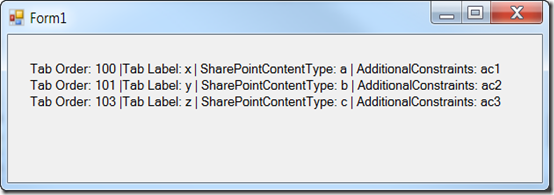Here’s a quick example using LINQ to parse some XML and get at the sweet, sweet attributes therein.
Here’s the XML I want to parse:
<?xml version="1.0" encoding="utf-8" ?>
<DeafultConfigurationSets>
<PageLayouts><PageLayout name="xyzzy">
<Tabs>
<Tab TabOrder="1" TabLabel="x" SharePointContentType="a" AdditionalConstraints="ac1"/>
<Tab TabOrder="2" TabLabel="y" SharePointContentType="b" AdditionalConstraints="ac2"/>
</Tabs>
</PageLayout><PageLayout name="xyzzy2">
<Tabs>
<Tab TabOrder="100" TabLabel="x" SharePointContentType="a" AdditionalConstraints="ac1"/>
<Tab TabOrder="101" TabLabel="y" SharePointContentType="b" AdditionalConstraints="ac2"/>
<Tab TabOrder="103" TabLabel="z" SharePointContentType="c" AdditionalConstraints="ac3"/>
</Tabs>
</PageLayout></PageLayouts>
</DeafultConfigurationSets>
I want to build up some tabs at runtime by parsing the above. My tabs depend upon a page layout. If my page layout’s name is “xyzzy2” then I want to get tabs 100, 101 and 103 (the tabs in <PageLayout name=”xyzzy2”>).
Here’s the LINQ that does it:
var allTabs =
from p in
XElement.Parse(theXmlToParse).
Elements("PageLayouts").
Elements("PageLayout")
where (p.Attribute("name").Value.Equals("xyzzy2"))
from m in p.Elements("Tabs").Elements("Tab")
select m;Results.Text = string.Empty;
foreach (var aTab in allTabs)
{
Results.Text +=
"Tab Order: " + aTab.Attribute("TabOrder").Value + " |" +
"Tab Label: " + aTab.Attribute("TabLabel").Value + " | " +
"SharePointContentType: " + aTab.Attribute("SharePointContentType").Value + " | " +
"AdditionalConstraints: " + aTab.Attribute("AdditionalConstraints").Value + "\r";
}
In the above, the variable “theXmlToParse” is a string variable, but you can use the load() method on a stream if you like.
“Results” is a label on a web form and when this code executes, it looks like this:
I haven’t worked out how to sort the results yet, so I’ll leave that for a future blog post.
</end>
Follow me on Twitter at http://www.twitter.com/pagalvin
